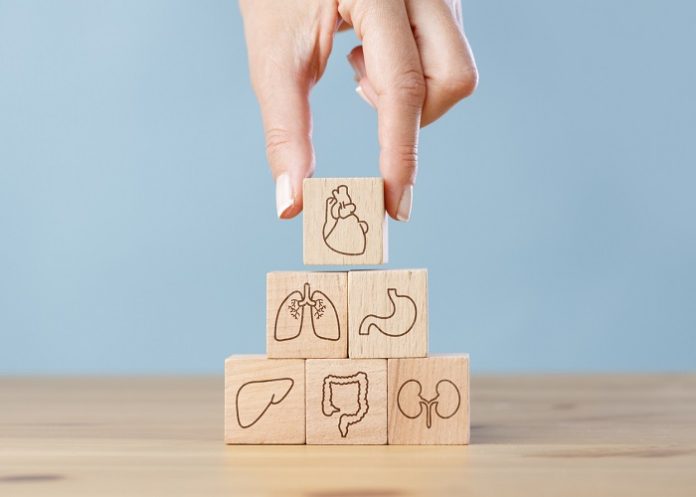Worldwide, about 20 people die every day while waiting for an organ transplant, but a promising advance from German scientists offers a potential solution – a “heart patch” made from stem cells that could provide a bridge to transplantation, or maybe even a permanent fix.
Made from adult human stem cells, these patches of heart muscle can be sutured on to a patient’s heart in a minimally invasive surgery to help it pump, the journal Nature has reported.
Each patch contains lab-grown cardiac tissue made of up to 200m cells embedded in a collagen hydrogel. The patch, called engineered heart muscle, or EHM, was proven to work in rhesus macaques, and the first human to get a patch was a 46-year-old woman in 2021, helping her survive until she could get a heart transplant.
The patches were then used on 15 other patients with severe heart failure, with more data on those cases expected by the end of the year.
The innovation represents a step forward in the larger quest to solve the heart transplant crisis. About 50 000 people worldwide have end-stage heart failure, but only 5 000 heart transplants are performed annually because of the shortfall of donor hearts.
That makes the “bridge-to-transplant” development important, researchers say. Clinical trials may reveal whether this could one day end the need for a transplant altogether.
‘Patchwork’
What’s remarkable about the heart muscle patches is they can be engineered from induced pluripotent stem cells (iPSCs), as opposed to embryonic stem cells, which present ethical issues.
iPSCs are reprogrammed from adult stem cells to become any cell type in the body, in this case, cardiomyocytes in the heart.
Arrhythmia or tumour growth can occur when pluripotent stem cells are put into tissue, as the organ may reject the new cells, or the heart may develop issues with its own electrical system. But that didn’t happen with the new heart patch.
On whether these patches can be brought up to scale, British pharmacologist Sian Harding, PhD, was certain they could.
“I’ve made these patches myself,” said Harding, an emeritus professor of cardiac pharmacology at Imperial College London, and author of The Exquisite Machine: The New Science of the Heart.
She estimated a cost of about $15 000 "to make a really solid piece of tissue about the size of your palm that would cover up the heart damage from a heart attack”. That’s not unreasonable for a heart implant, she said.
Right now, the most common treatments for people with heart failure other than transplant include medications, mechanical devices, bypass operations, and lifestyle changes.
ACE inhibitors help relax blood vessels and decrease blood pressure. Beta-blockers block the effects of adrenaline and noradrenaline on the heart to decrease heart rate, blood pressure, and heart contraction force.
Sodium-glucose transporter-2 (SGLT-2) inhibitors like Jardiance lower blood sugar levels and reduce the risk of heart attacks or strokes.
These medications are generally well-tolerated and effective, but they can become less effective over time or cause adverse effects.
They may also not be effective enough for those who certainly will need a transplant at some point in the future.
Meanwhile, mechanical devices like left ventricular assist devices – or LVADs, for short – can be lifesaving but are invasive. LVADs are implanted during open-heart surgery and take blood from the left ventricle and pump it into the aorta, where it can then be pumped throughout the rest of the body. This improves blood flow and reduces heart failure symptoms.
“In the US, the main things we rely upon are mechanical assist devices for pump failure, whether that be as a therapy for heart failure by itself, or as a mechanism to get them towards transplant later on in life,” said Sounok Sen, MD, a cardiologist and assistant professor of medicine at Yale School of Medicine.
LVADs have proved to improve quality and quantity of life, although there are trade-offs, said Sen. Patients must accept living with a pump, and understand they will have to carry equipment around with them, along with batteries and controllers. Plus, they may still develop right-sided heart failures.
“LVADs require lines that go into the body and need an external battery pack, which patients have to carry around with them, and charge up,” Harding said. “Apart from which, they can also get chronic infection from the lines.”
Study details
Engineered heart muscle allografts for heart repair in primates and humans
Ahmad-Fawad Jebran, Tim Seidler, Malte Tiburcy et al.
Published in Nature on 29 January 2025
Abstract
Cardiomyocytes can be implanted to remuscularise the failing heart. Challenges include sufficient cardiomyocyte retention for a sustainable therapeutic impact without intolerable side effects, such as arrhythmia and tumour growth. We investigated the hypothesis that epicardial engineered heart muscle (EHM) allografts from induced pluripotent stem cell-derived cardiomyocytes and stromal cells structurally and functionally remuscularise the chronically failing heart without limiting side effects in rhesus macaques. After confirmation of in vitro and in vivo (nude rat model) equivalence of the newly developed rhesus macaque EHM model with a previously established Good Manufacturing Practice-compatible human EHM formulation, long-term retention (up to 6 months) and dose-dependent enhancement of the target heart wall by EHM grafts constructed from 40 to 200 million cardiomyocytes/stromal cells were demonstrated in macaques with and without myocardial infarction-induced heart failure. In the heart failure model, evidence for EHM allograft-enhanced target heart wall contractility and ejection fraction, which are measures for local and global heart support, was obtained. Histopathological and gadolinium-based perfusion magnetic resonance imaging analyses confirmed cell retention and functional vascularization. Arrhythmia and tumour growth were not observed. The obtained feasibility, safety and efficacy data provided the pivotal underpinnings for the approval of a first-in-human clinical trial on tissue-engineered heart repair. Our clinical data confirmed remuscularisation by EHM implantation in a patient with advanced heart failure.
WebMD article – New 'Heart Patch' Could Help Solve the Transplant Shortage (Open access)

